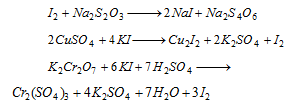Types of titrations : Titrations can be classified as :
(1) Acid base titrations or alkalimetry and acidimetry
(2) Redox titrations or Oxidation reduction titrations
(3) Precipitation titrations
(4) Complexometric titrations.
(1) Acid-base titrations : When the strength of an acid is determined with the help of a standard solution of base, it is defined as acidimetry. Same as, when the strength of a base (alkali) is determined with the help of a standard solution of an acid, it is known as alkalimetry. Both these titrations involve neutralisation of an acid with an alkali. In these titrations H+ ions of the acid combine with OH- ions of the alkali to form unionised molecules of water.

The end point in these titrations is determined by the use of organic dyes which are either weak acids or weak bases. These modify their colours within a limited range of hydrogen ion concentrations, i.e.,pH of the solution. Phenolphthalein is a suitable indicator in the titrations of strong alkalies (free from carbonate) against strong acids or weak acids. Methyl orange is act as an indicator in the titrations of strong acids against strong and weak alkalies. As no indicator provides correct results in the titrations of weak acids against weak bases, such titrations are performed by some other methods (physical methods).
(2) Oxidation reduction titrations : The titrations based on oxidation-reduction reactions are called redox titrations. The chemical reactions proceed with transfer of electrons (simultaneous loss or gain of electrons) among the reacting ions in aqueous solutions. Sometimes these reactions are known after the reagent used, as:
(i) Permanganate titrations : These are titrations in which potassium permanganate is used as an oxidising agent in acidic medium. The medium is organized by the use of dilute sulphuric acid. Potassium permanganate performs as a self-indicator. The potential reaction, when potassium permanganate performs as an oxidising agent, is:

Before the end point, the solution remains colourless (when KMnO4 solution is taken in burette) but after the equivalence point only one extra drop of KMnO4 solution imparts pink colour, i.e., presence of pink colour shows the end point. Potassium permanganate is needed for the estimation of ferrous salts, oxalates, oxalic acid, hydrogen peroxide, etc. The solution of potassium permanganate is always first standardised before its use.
(ii) Dichromate titrations : These are titrations in which, potassium dichromate is used as an oxidising agent in acidic medium. The medium is managed acidic by the use of dilute sulphuric acid. The potential reaction is

The solution of potassium dichromate can be directly used for titrations. It is usually used for the estimation of ferrous salts and iodides. In the titration of K2Cr2O7 versus ferrous salt either an external indicator (potassium ferricyanide) or an internal indicator (diphenyl amine) can be used.
(iii) iodometric titrations and Iodimetric : The reduction of free iodine to iodide ions and oxidation of iodide ions to free iodine occurs in these titrations.

These are divided into two types :
(a) Iodimetric titrations : These are the titrations in which free iodine is used. As it is hard to create the solution of iodine (volatile and less soluble in water), it is reacted in potassium iodide solution.

This solution is first standardised before use. With the standard solution of I2. Substances such as sulphite, arsenite, thiosulphate, are calculated.
(b) Iodometric titrations : In iodometric titrations, an oxidising agent is allowed to react in neutral medium or in acidic medium, with excess of potassium iodide to liberate free iodine.

Free iodine is titrated against a standard reducing agent usually with sodium thiosulphate. Halogens, dichromates, oxyhalogens, cupric ion, peroxides, etc., can be estimated by this method.

In iodimetric and iodometric titrations, starch solution is used as an indicator. Starch solution provides blue or violet colour with free iodine. At the last point the violet or blue colour disappears when iodine is completely changed to iodide.
(3) Precipitation titrations : The titrations which are based on the formation of insoluble precipitates, when the solvent of two reacting solution are brought in contact with each other, are known as precipitation titrations. For example, when a solvent of silver nitrate is reacted to a solution of sodium chloride or a solution of ammonium thiocyanate, a white substance of silver thiocyanate or silver chloride is formed.

Such titrations involving silver nitrate are known as argentometric titrations.
(4) Complexometric titrations : A titration, in which an dissolved complex is formed at the equivalence point, is known as complexometric titration. These titrations are superior to precipitation titrations as there is no error due to co-precipitation.

EDTA (ethylenediamine tetra-acetic acid) is a useful reagent which forms complexes with solids. In the form of disodium salt, it is needed to estimate Ca2+ and Mg2+ ions in presence of eriochrome black-T as an indicator.
Email based Chemistry assignment help - homework help at Expertsmind
Are you searching chemistry expert for help with Types of Titrations questions? Types of Titrations topic is not easier to learn without external help? We at www.expertsmind.com offer finest service of Chemistry assignment help and chemistry homework help. Live tutors are available for 24x7 hours helping students in their Types of Titrations related problems. We provide step by step Types of Titrations question's answers with 100% plagiarism free content. We prepare quality content and notes for Types of Titrations topic under chemistry theory and study material. These are avail for subscribed users and they can get advantages anytime.
Why Expertsmind for assignment help
- Higher degree holder and experienced experts network
- Punctuality and responsibility of work
- Quality solution with 100% plagiarism free answers
- Time on Delivery
- Privacy of information and details
- Excellence in solving chemistry queries in excels and word format.
- Best tutoring assistance 24x7 hours